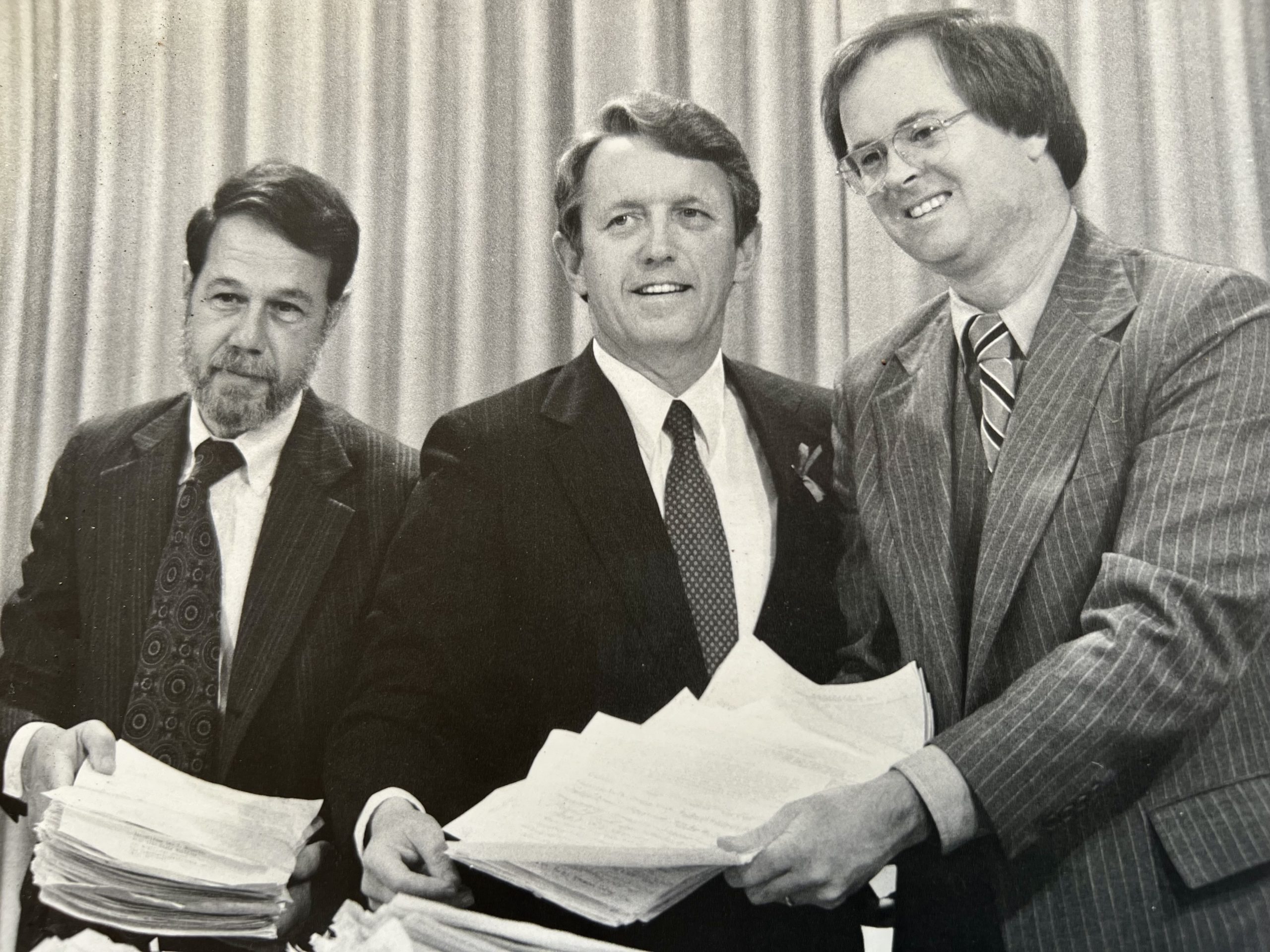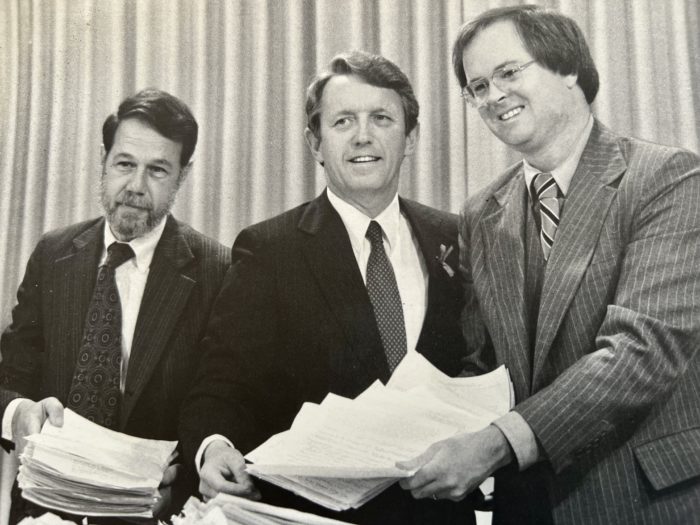
Sanctuary 30th Anniversary Series – Blog #5 “Finding sanctuary: The politics of saving the bay” by Sam Farr
Monterey Bay, the largest open bay on the California Coast, is where ocean politics began. From the first Spanish explorers discovering our coastline beauty, to the creation of the Monterey Bay National Marine Sanctuary, our waters have been controversial.
Sam FarrThere are four parts to the story of protecting Monterey Bay and the central coast. First, is the discovery of, and the effort to halt, the offshore oil Lease Sale 53. The second is discovering and promoting marine sanctuary status for Monterey Bay and the central coast. The third is choosing the “whole enchilada” or the largest possible boundary, to provide complete protection, and setting up its office, staffing and the Sanctuary Exploration Center. The fourth is the effort to enact a National Standard for Ocean Protection, as had been done for Clean Air and Clean Water. This last is still a work in progress for the nation but we’re demonstrating how to do that right here in Monterey Bay.
Exploiting the bay
The politics of ocean law started in Monterey with the building the Custom House (California’s Historical Property No. 1) where all merchant ships had to register before doing business in California waters. The sea was the only way in or out for decades before overlanders arrived; Monterey Bay was the economic portal.
For more than 100 years, the state’s economy was based on exploiting the resources of the sea. It started with harvesting sea otters and seals for their fur, using ocean passages to ship hundreds of thousands of cow hides from mission ranches, and establishing major whaling operations around Monterey Bay – the whale killing capital of California. From the early 1900s until the 1950s, Monterey was the sardine capital of the world. All these takings for economic prosperity left the sea otters nearly extinct, bankrupted Cannery Row, and put pressure to build oil refineries in Moss Landing with access for oil tankers to serve PG&E’s “Mighty Mo” power plant.
Monterey Bay, one of the largest nearshore volumes of water in the world due to the depth of the underwater Monterey Bay canyon, was going downhill fast. This degradation was the result of more than 100 years of political decision making.
To recover and move forward, we needed a new politic. One that favored resource protection over resource destruction. On land it was the creation of State Parks, in the ocean it was creation of State Marine Reserves and Federal Ocean Sanctuaries.
Offshore oil a motivator
The motivating force for ocean protection was the threat of offshore oil drilling. For Northern California, the urgency came about in the late 1970s. I was chairman of the Monterey County Board of Supervisors when I received a call from my good friend and neighbor, the late Jim Rote. At the time, Rote was working on marine biology policy in the state legislature. Rote then took a temporary job in Washington, D.C., working with the National Marine Fisheries.
Rote told me the Department of the Interior was about to announce a call for bids from oil companies for oil exploration off the Central Coast of California. My response was “That’s nuts, there’s no oil off our Central California coast.” Jim said, “Wait until you see how the oil companies respond to the call.” This call for bids was named Lease Sale 53 and more oil companies showed interest in this leasing opportunity than in any prior call.
A region mobilizes
The news came out and people hit the roof and our central coast mobilized. Protection of our coastline was a great organizing tool; every political leader in the region opposed Lease Sale 53. Chambers of commerce catalyzed opposition from the tourism industry and agricultural farmers due to threats of air pollution and oil spills. I think it was the first time such diverse interests were all on the same page in opposition to an economic threat to our region.
During this time, Jimmy Carter was president. He was facing the worst energy crisis in modern history. California had gas rationing with record long lines at gas stations. Everyone needed gas and diesel fuel, especially the midwest “breadbasket” farmers. For most of the country announcing oil drilling expansion was good news, but not for California. Our coastline was our center of population and economic development. Coastal tourism and coastal agriculture were huge. Even fishermen were on our side to stop Lease Sale 53. It was the central California coast against the rest of the nation.
Local leaders stepped up. Photographer Ansel Adams took out ads in the New York Times opposing the high-risk and low fuel gain that would come from drilling. Our cry was heard by the White House and through local connections, Secretary of the Interior Cecil Andrus came to Monterey to hear our concerns. I still have a copy of the T-shirt I gave him saying “Stop Lease Sale 53.” He saw a united front and listened. It worked and President Carter removed Lease Sale 53. We won, but not for long.
Finding a permanent solution
Ronald Reagan defeated Jimmy Carter in 1980. His new secretary of interior was James Lee Watt. Secretary Watt immediately announced that the entire coast of California was up for lease sale. We went to work with our already well-organized regional opposition. This time with the California legislature and our California congressional delegation, led by then Congressman Leon Panetta. We needed time to convince our former California Governor, now President Reagan, to stop Secretary Watt’s call to “drill baby drill” off our coast.
Panetta organized a group of coastal congressmen to help. Congressman Vic Fazio, who was on the powerful Appropriations Committee, was urged to put language in the annual appropriations bill to prohibit the Department of the Interior from spending money that fiscal year on the lease sale; that action temporarily halted the process. This approach to stopping the lease sale had to be repeated in Congress annually with no guarantee it would be successful.
In my next installment: Work begins on a marine sanctuary, the fight against offshore oil continues, and putting the ocean atop the nation’s agenda.

Sam Farr is a member of the Monterey Bay National Marine Sanctuary Foundation Board of Directors. He served on the Monterey County Board of Supervisors, the California State Assembly, and represented the central California Coast in the US House of Representatives. He also served as a Peace Corps volunteer in Colombia as a young man. He lives in Carmel with his wife, Shary. For more on the sanctuary’s 30th anniversary, go to montereybayfoundation.org.
About this series
Monterey Bay National Marine Sanctuary celebrates its 30th anniversary this fall, and the national sanctuary system celebrates its 50th. For the next 12 weeks, the Sentinel will publish columns by former U.S. Secretary of Defense Leon Panetta, along with Sam Farr, Dan Haifley, Fred Keeley, and Sanctuary Superintendent Dr. Lisa Wooninck. All of these contributors serve on the board of Monterey Bay National Marine Sanctuary Foundation and were involved with the Sanctuary’s designation.

